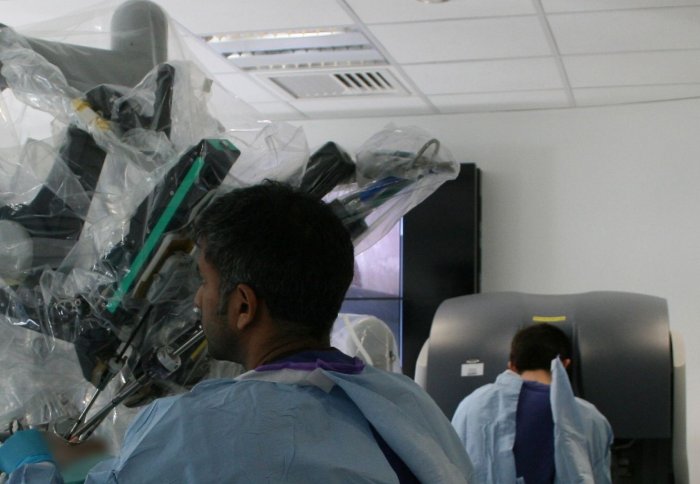

An Imperial College team was the first in the UK to run a robotic surgery course combining practice on soft tissue with computer simulations.
Minimally invasive surgery using robots has become increasingly popular over recent years and the ‘da Vinci’ robot is extensively used in this area. The robot enables surgeons to operate with improved precision and dexterity. It incorporates a 3-D high-definition visual system and special wristed instruments that bend and rotate to a far greater degree than the human wrist.
The training course at Imperial focused on using the da Vinci robot to treat mouth and throat cancers, in a procedure known as Trans Oral Robotic Surgery (TORS). The benefits of TORS include faster recovery times and smaller incision scars and there are currently 42 da Vinci robots in the UK and one is already in clinical use at the Imperial’s Surgery Innovation Centre at St Mary’s Hospital (part of Imperial College Healthcare NHS Trust).
It’s been an invaluable day, from simulated to tissue surgery all in the same centre
– Stuart Winter
participant on Imperial TORS course
Surgeons wishing to study robotic surgery encounter a steep learning curve, which has implications for patient safety. In the UK, surgeons have been able to train with da Vinci robots using computer simulations, but the one-day Imperial course is the first to offer the opportunity to practice on samples of soft tissue in an operating theatre environment.
Held on 15 February in the Imperial Surgical Innovation Centre on the College’s St Mary’s Campus, the course trained teams of two consultant surgeons and a theatre nurse.
The morning session was designed to develop robot-assisted operative skills using ‘Mimic’ simulators, together with software that provides feedback and exercises to improve performance.
In the afternoon session, course leader Neil Tolley, from the Department of Surgery and Cancer, guided trainees through a number of TORS procedures on a specially prepared sample of tissue.
One of the participants, Stuart Winter from Oxford University Hospitals NHS Trust, said: “It’s been an invaluable day, from simulated to tissue surgery all in the same centre. It has been an excellent preparation for live robotic surgery in the near future.
“The simulator helps the practice of key steps, but it can’t replicate the complexities and variations of human anatomy. This combination training provided a close to ‘real life’ experience and highlighted the logistical problems involved in performing robotic procedures.”
Neil Tolley added: “In the future, it is hoped that additional surgical specialties will embrace the opportunities for robotic surgical training at Imperial which has a history and culture of surgical innovation. Imperial’s surgical expertise, the facilities at the Imperial Surgical Innovation Centre and the fact that the Human Anatomy Unit is part of the Department of Surgery and Cancer, provide an ideal platform to lead robotic surgical training in the UK.”
Anyone interested in finding out more about future robotic surgery training courses can contact Neil Tolley on N.Tolley@imperial.ac.uk
- Words and pictures by Usama Syed
Article text (excluding photos or graphics) available under an Attribution-NonCommercial-ShareAlike Creative Commons license.
Photos and graphics subject to third party copyright used with permission or © Imperial College London.
Reporter
Franca Davenport
Communications and Public Affairs

Contact details
Email: press.office@imperial.ac.uk
Show all stories by this author



Leave a comment
Your comment may be published, displaying your name as you provide it, unless you request otherwise. Your contact details will never be published.